Understanding Padrón Chilies: Spain's Culinary Treasure
Native to the municipality of Padrón in northwestern Spain, these slender green peppers have become a staple in Spanish tapas culture. The famous Galician saying 'Os pementós de Padrón, uns pican e outros non' (Padrón peppers, some are hot and some are not) perfectly captures their unpredictable nature. This genetic variation makes every bite an exciting culinary adventure.
Physical Characteristics and Flavor Profile
Measuring 2-3 inches long with thin, slightly wrinkled skin, Padrón chilies start bright green and mature to red. Their flavor profile combines:
- Grassy, vegetal notes when young
- Sweet undertones as they mature
- Occasional intense heat (1 in 10 peppers)
- Distinctive earthy finish

The Science Behind the Heat Variability
Unlike most chili varieties with consistent heat levels, Padrón peppers exhibit significant variation due to:
| Factor | Effect on Heat Level |
|---|---|
| Genetic diversity | Natural variation in capsaicin production |
| Stress conditions | Drought or nutrient deficiency increases heat |
| Maturity stage | Red-ripe peppers generally hotter than green |
| Position on plant | Peppers at plant extremities often hotter |
Growing Padrón Peppers Successfully
For gardeners interested in growing Padrón peppers at home, these Spanish heirlooms require:
- Full sun exposure (6-8 hours daily)
- Well-draining soil with pH 6.0-7.0
- Consistent moisture (avoid water stress)
- Warm temperatures (70-85°F ideal)
- 100-120 day growing season
Start seeds indoors 8-10 weeks before last frost. Unlike many commercial peppers, Padrón varieties thrive with minimal intervention, making them excellent for organic gardening. The best time to harvest Padrón chilies is when they reach 2-3 inches in length and maintain vibrant green color, though allowing some to ripen to red increases flavor complexity.
Traditional Preparation Methods
The iconic Spanish preparation method requires minimal ingredients but precise technique:
- Wash and thoroughly dry peppers
- Heat olive oil in cast-iron skillet until shimmering
- Add whole peppers in single layer
- Cook 3-5 minutes until blistered and slightly charred
- Sprinkle generously with coarse sea salt
This simple authentic Padrón pepper recipe highlights their natural flavor while creating the signature blistered texture. For those wondering how to cook Padrón chilies without making them too hot, avoid piercing the skin during cooking, as this releases more capsaicin.

Nutritional Benefits and Storage Tips
These peppers offer impressive nutritional value per 100g serving:
- Vitamin C: 144mg (160% daily value)
- Vitamin A: 3131 IU (63% daily value)
- Dietary fiber: 2.8g
- Vitamin B6: 0.3mg
For optimal freshness, store unwashed Padrón chilies in perforated plastic bags in the refrigerator crisper drawer for up to two weeks. For longer preservation, freezing Padrón peppers maintains flavor better than canning—simply blanch for 2 minutes, cool in ice water, then freeze on baking sheets before transferring to freezer bags.
Finding and Substituting Padrón Chilies
When searching where to buy Padrón peppers near me, check:
- Specialty grocery stores (Whole Foods, Trader Joe's)
- Hispanic markets during summer months
- Local farmers' markets (peak season July-September)
- Online seed catalogs for home cultivation
If unavailable, suitable substitutes include:
- Fresno peppers (more consistently hot)
- Shishito peppers (similar mild profile)
- Italian frying peppers (milder alternative)
Understanding Padrón pepper vs shishito pepper differences is crucial—while both offer the mild-with-occasional-heat experience, Padróns typically have more complex flavor and slightly higher heat potential.
Common Questions About Padrón Chilies
Are all Padrón peppers spicy?
No, approximately 90% of Padrón peppers are mild with subtle grassy flavor, while about 10% deliver surprising heat. This natural variation is their defining characteristic, making each pepper a culinary surprise.
How hot are Padrón chilies compared to jalapeños?
The hottest Padrón peppers reach about 2,000 Scoville Heat Units (SHU), significantly milder than jalapeños which range from 2,500-8,000 SHU. Most Padróns are comparable to bell peppers in heat level, with only occasional specimens approaching mild jalapeño intensity.
Can you eat Padrón peppers raw?
Yes, Padrón peppers can be eaten raw in salads or as crudités, though traditional preparation involves blistering in olive oil. Raw peppers have a crisp, grassy flavor with subtle heat in approximately 10% of specimens. Cooking enhances their natural sweetness and creates the characteristic blistered texture.
What makes some Padrón peppers hot while others are mild?
The heat variation stems from genetic diversity and environmental factors. Peppers experiencing more stress (drought, nutrient deficiency) produce higher capsaicin levels. Position on the plant also matters—those at extremities often develop more heat. This natural variation is why Padrón peppers offer a 'Russian roulette' eating experience.
How do you grow Padrón peppers in cooler climates?
In cooler regions, start Padrón seeds indoors 8-10 weeks before last frost. Use black plastic mulch to warm soil, and consider growing in containers that can be moved to sunny locations. Choose a south-facing wall for maximum heat retention, and water consistently to prevent stress that might increase heat levels unpredictably.











 浙公网安备
33010002000092号
浙公网安备
33010002000092号 浙B2-20120091-4
浙B2-20120091-4